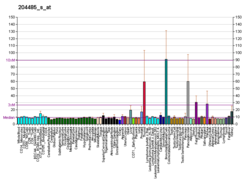| TOM1L1 |
|---|
|
| Available structures |
|---|
| PDB | Ortholog search: PDBe RCSB |
|---|
|
|
| Identifiers |
|---|
| Aliases | TOM1L1, OK/KNS-CL.3, SRCASM, target of myb1 like 1 membrane trafficking protein |
|---|
| External IDs | OMIM: 604701; MGI: 1919193; HomoloGene: 38055; GeneCards: TOM1L1; OMA:TOM1L1 - orthologs |
|---|
| Gene location (Human) |
|---|
 | | Chr. | Chromosome 17 (human)[1] |
|---|
| | Band | 17q22 | Start | 54,899,387 bp[1] |
|---|
| End | 54,961,956 bp[1] |
|---|
|
| Gene location (Mouse) |
|---|
 | | Chr. | Chromosome 11 (mouse)[2] |
|---|
| | Band | 11 D|11 55.47 cM | Start | 90,534,291 bp[2] |
|---|
| End | 90,579,192 bp[2] |
|---|
|
| RNA expression pattern |
|---|
| Bgee | | Human | Mouse (ortholog) |
|---|
| Top expressed in | - jejunal mucosa
- duodenum
- islet of Langerhans
- body of pancreas
- rectum
- kidney tubule
- right lobe of liver
- corpus epididymis
- body of stomach
- human kidney
|
| | Top expressed in | - seminal vesicula
- white matter of spinal cord
- yolk sac
- lens
- tail of embryo
- zygote
- genital tubercle
- duodenum
- stomach
- choroid plexus of fourth ventricle
|
| | More reference expression data |
|
|---|
| BioGPS |  | | More reference expression data |
|
|---|
|
| Gene ontology |
|---|
| Molecular function | - SH3 domain binding
- clathrin binding
- protein kinase activator activity
- ubiquitin binding
- protein binding
- protein kinase binding
| | Cellular component | - cytoplasm
- cytosol
- endosome
- Golgi apparatus
- membrane
- intracellular anatomical structure
- Golgi stack
- lysosome
- endosome membrane
- extracellular exosome
| | Biological process | - regulation of DNA biosynthetic process
- negative regulation of mitotic nuclear division
- positive regulation of protein autophosphorylation
- protein transport
- ubiquitin-dependent protein catabolic process via the multivesicular body sorting pathway
- intracellular protein transport
- activation of protein kinase activity
- signal transduction
- transport
| | Sources:Amigo / QuickGO |
|
| Orthologs |
|---|
| Species | Human | Mouse |
|---|
| Entrez | | |
|---|
| Ensembl | | |
|---|
| UniProt | | |
|---|
| RefSeq (mRNA) | |
|---|
NM_005486
NM_001321173
NM_001321174
NM_001321175
NM_001321176 |
| |
|---|
NM_028011
NM_001357543
NM_001357544
NM_001357547 |
|
|---|
| RefSeq (protein) | |
|---|
NP_001308102
NP_001308103
NP_001308104
NP_001308105
NP_005477 |
| |
|---|
NP_082287
NP_001344472
NP_001344473
NP_001344476 |
|
|---|
| Location (UCSC) | Chr 17: 54.9 – 54.96 Mb | Chr 11: 90.53 – 90.58 Mb |
|---|
| PubMed search | [3] | [4] |
|---|
|
| Wikidata |
| View/Edit Human | View/Edit Mouse |
|


















